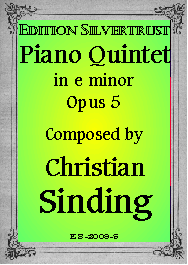Presents
Christian Sinding
Piano Quintet in c minor, Op.5
 Upon the
premiere of Christian Sinding's Piano Quintet in 1889, the prestigious
Musikalisches Wochenblatt of Leipzig commented as follows:
Upon the
premiere of Christian Sinding's Piano Quintet in 1889, the prestigious
Musikalisches Wochenblatt of Leipzig commented as follows:
"This work demonstrates in all four of its movements a simply astounding talent for invention and combination as well as a wonderful sense of sound effect. At the same time, the ideas are so masterfully executed and such a splendid contrast of themes is in evidence throughout, that one cannot cease to voice one's admiration for this very important work which both is daring and individual."
The Quintet created an immediate sensation, not only because it violated many established rules of composition (such as the use of parallel fifths) but also by virtue of its great originality and fecundity of musical ideas. Composers such as Tchaikovsky, Busoni and Sibelius praised it lavishly
Christian Sinding (1856-1941), along with Edvard Grieg came to symbolize Norwegian classical music between 1885 and 1940. Born is the small town of Kongsberg near Oslo, Sinding, after studying music in Oslo, attended the Leipzig Conservatory where he studied violin with Henry Schradieck and composition with Salomon Jadassohn and Carl Reinecke. Whereas Grieg's style of writing has been described as Schumann's technique combined with Norwegian folk melody, Sinding's is often and incorrectly characterized as combination of Wagner's technique with Norwegian folk melody. Although the influence of Norwegian folk melody can be found in his music, Sinding did not use it, as did Grieg, so extensively. Rather, it was German romanticism, and in particular the music of Liszt and Wagner, which greatly influenced Sinding. But unlike Liszt and Wagner, Sinding relied on wit and developed a more cosmopolitan style. Writing in virtually all genres, his chamber music is an important part of his output.
The opening Allegro moderato ma non troppo begins cautiously. Sinding builds his theme carefully and the powerful episodes of intense drama fit together seamlessly with the lyrical sections with which they are interspersed. The big Andante which follows begins softly with intense and lovely melody reminiscent of Schubert. The music calmly unfolds in a very leisurely fashion but the seeds of drama, which occur many minutes later, are already sown. A lively and fresh Vivace. A soft and mysterious bridge passage leads to the vibrant and somewhat exotic second theme. The massive finale, Allegro vivace, immediately opens with great power and drive as all of the voices push the energetic music forward. Like a storm, it finally exhausts itself, leading to a slower and more solemn theme. Then, Sinding cleverly weaves the first theme into the minor mode of the second theme. Again tension builds and a long and dramatic section of incredible ferocity follows leading to an exciting ending.
Here is a masterwork for piano quintet, the equal of anything from its era. It is truly unfathomable that it does not appear on concert programs. We strongly encourage professionals and amateurs alike to make its acquaintance.
Parts: $39.95